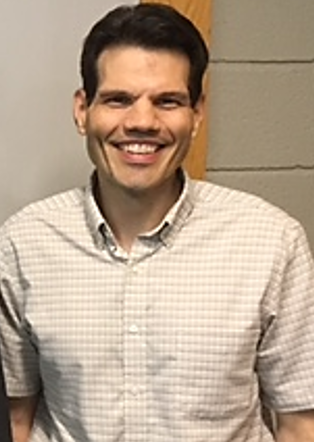David Wipf
Classification
- Faculty
Discipline
- Analytical
- Materials/Polymer
Research Summary
Electrochemistry, corrosion with materials applications, and scanning probe microscopyTitle
- Professor
Contact
dwipf@chemistry.msstate.edu
662-325-7608
Address
- Hand Lab 2220
B.S. South Dakota, 1984
Ph.D. Indiana University, 1989
Scanning Electrochemical Microscopy
We base our research on developing new instrumentation and experimental methods in electrochemistry and scanning probe microscopy. A major focus of this work is development of new capabilities for the scanning electrochemical microscope (SECM). The SECM examines a sample by scanning a microscopic electrode sensor across its surface. As a result, the tip signal produces chemical and topographical maps. The figure shows an example image of aircraft grade aluminum alloy in solution. The “peaks” in the image are actually regions of enhanced reduction current. Images such as these can help predict and control corrosion at the microscopic level.
Materials for Batteries and Supercapacitors
Another area of interest is producing and testing new materials for next generation batteries and supercapacitors. The image shows an electron microscope image of a new nanoflake Ni-C-S material that was developed in our laboratory. It shows high charge capacity and is a candidate as a component in new alkaline batteries.
Catalysts for Energy Production
One very interesting aspect of the scanning electrochemical microscope (SECM) is the ability to directly image rates of heterogeneous catalysis. In our group, we are using the SECM to examine the rates of hydrogen ion reduction, oxygen reduction, and hydrogen reduction on electrochemical catalysts. The SECM can show differences in rates due to different crystallographic orientation. This information can be used to develop improved catalytic materials for use in fuel cells, oxygen evolution, carbon dioxide reduction, etc. The image at left shows the variation in hydrogen oxidation at a platinum electrode. The different colors show that the rate of the reaction varies at different microscopic crystalline regions.
Corrosion of Materials
One area of traditional interest is using electrochemical methods to study corrosion of metals. A focus in our lab is to understand the relationship between the microscopic structure of metals and the activity or propensity for corrosion. My students have used the SECM method to examine numerous materials such as Mg, Ni, and ferrous alloys.
Selected Publications
1. “Spatially variant red blood cell crenation in alternating current non-uniform fields,” R. An, D. O. Wipf, and A. R. Minerick, Biomicrofluidics, 2014, 8, 021803.
2. “A New Charging Method for Li-Ion Batteries: Dependence of the Charging Time on the Direction of an Additional Oscillating Field,” Ibrahim Abou Hamad, M. A. Novotny, D. O. Wipf, and P. A. Rikvold, ECS Transactions 2011, 33, 33-37.
3. “A new battery-charging method suggested by molecular dynamics simulations,” Ibrahim Abou Hamad, M. A. Novotny, D. O. Wipf, and P. A. Rikvold, Phys. Chem. Chem. Phys., 2010, 12, 2740-2743.
4. “Rapid Determination of Zeptomole Quantities of Pb2+ with the Mercury Monolayer Carbon Fiber Electrode,” Grigore Munteanu, Sorin Munteanu, and David O. Wipf, J. Electroanal. Chem., 2009, 632, 177-183.
5. “Fabrication of Carbon-Encapsulated Mono- and Bimetallic (Sn and Sn/Sb Alloy) Nanorods. Potential Lithium-Ion Battery Anode Materials,” Sang Ho Lee, Martin Mathews, Hossein Toghiani, David O. Wipf, and Charles U. Pittman, Jr., Chemistry of Materials, 2009, 21, 2306-2314.
6. “Local Electron-Transfer Rate Measurements on Modified and Unmodified Glassy-Carbon Electrodes” Robert C. Tenent and David O. Wipf, J. Solid State Electrochem., 2009, 80, 583-590
7. "Imaging of Metal Ion Dissolution and Electrodeposition by Anodic Stripping Voltammetry – Scanning Electrochemical Microscopy" Mario Alpuche-Aviles, John E. Baur, and David O. Wipf, Anal. Chem., 2008, 80, 3612–3621.
